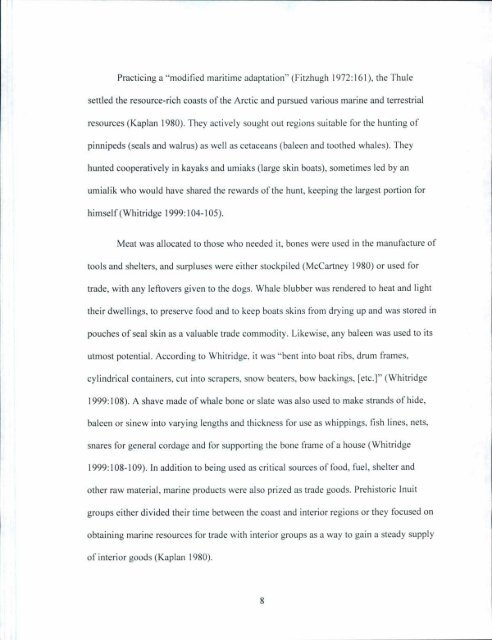v=c§J - Memorial University of Newfoundland DAI
v=c§J - Memorial University of Newfoundland DAI
v=c§J - Memorial University of Newfoundland DAI
You also want an ePaper? Increase the reach of your titles
YUMPU automatically turns print PDFs into web optimized ePapers that Google loves.
Practicing a "modified maritime adaptation" (Fitzhugh 1972: 161), the Thule<br />
settled the resource-rich coasts <strong>of</strong> the Arctic and pursued various marine and terrestrial<br />
resources (Kaplan 1980). They actively sought out regions suitable for the hunting <strong>of</strong><br />
pinnipeds (seals and walrus) as well as cetaceans (baleen and toothed whales). They<br />
hunted cooperatively in kayaks and umiaks (large skin boats), sometimes led by an<br />
umialik who would have shared the rewards <strong>of</strong>the hunt, keeping the largest portion for<br />
himself (Whitridge 1999: 104-1 05).<br />
Meat was allocated to those who needed it. bones were used in the manufacture <strong>of</strong><br />
tools and shelters, and surpluses were either stockpiled (McCartney 1980) or used for<br />
trade, with any leftovers given to the dogs. Whale blubber was rendered to heat and light<br />
their dwellings, to preserve food and to keep boats skins from drying up and was stored in<br />
pouches <strong>of</strong> seal skin as a valuable trade commodity. Likewise, any baleen was used to its<br />
utmost potential. According to Whitridge. it was "ben! into boat ribs. drum frames,<br />
cylindrical containers, cut into scrapers. snow beaters. bow backings. [etc.]" (Whitridge<br />
1999: I08). A shave made <strong>of</strong>whale bone or slate was also used to make strands <strong>of</strong> hide,<br />
baleen or sinew into varying lengths and thickness for use as whippings. fish lines, nets,<br />
snares for general cordage and for supporting the bone frame <strong>of</strong>a house (Whitridge<br />
1999: I08-1 09). In addition to being used as critical sources <strong>of</strong> food, fuel, shelter and<br />
other raw material, marine products were also prized as trade goods. Prehistoric Inuit<br />
groups either divided their time between the coast and interior regions or they focused on<br />
obtaining marine resources for trade with interior groups as a way to gain a steady supply<br />
<strong>of</strong> interior goods (Kaplan 1980).

















